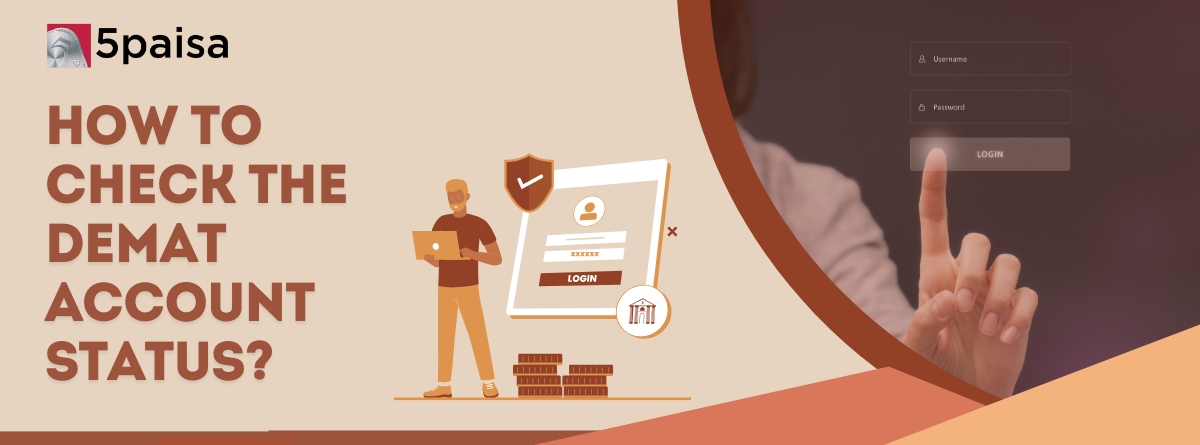How to Check Your Demat Account Status
5paisa Research Team
Last Updated: 27 Jan, 2025 03:44 PM IST

Content
- The Demat Account Statement
- Accessing Your Demat Account Statement
- Steps to Check Your Demat Account Status
- Important Things to Consider While Understanding Your Demat Account Statement
- Why Monitoring Your Demat Account Is Essential
- Practical Tips for Managing Your Demat Account
- Conclusion
The Demat Account Statement
A Demat account is like a digital vault. It holds your shares, bonds, mutual funds, and other financial instruments electronically. Think of a Demat account like your savings bank account. Just as you can check your bank balance, view weekly or monthly statements, and track transactions on your smartphone, a Demat account allows you to view all your holdings (shares, bonds, mutual funds), profits, losses, and transaction history in one place.
This digital account holds your securities in electronic form and acts as a gateway to the stock market. Whether through a broker’s platform, mobile app, or the depository’s website, this statement is your go-to resource for tracking investments.
When you operate a Demat account through a Depository Participant (DP), you gain access to a trading portal, either via a mobile app or a website. This portal offers:
- Demat Holding Statements: View details of your securities and their current status.
- Trading Insights: Get stock advice, charts, and strategies.
- Activity Tracking: Monitor your profits, losses, and transaction summaries.
For more comprehensive details, you can access your Demat account statement through the Central Depository Services Limited (CDSL) or National Securities Depository Limited (NSDL) platforms.
More About Demat Account
- How to Check Your Demat Account Status
- What is Demat Debit and Pledge Instruction(DDPI)?
- Loan Against Shares
- How to Find Demat Account Number from PAN
- How to fill a Dematerialisation Request Form
- Dematerialization of Shares: Process and Benefits
- What Is DP ID In The Demat Account
- What Is Dematerialization of Shares?
- What Is a Demat Account Holding Statement?
- Low Brokerage Charges in India
- How to Choose Right Demat Account – Key Factors & Tips
- Do we need a Demat Account for Mutual Funds?
- Aims and Objectives of Demat Account
- What is BO ID?
- What is a bonus share?
- How to Close a Demat Account
- How to Open Demat Account Without Aadhaar Card
- Open Demat Account Without A PAN Card - A Complete Guide
- Myths & Facts about Demat Account
- What is Collateral Amount in Demat Account?
- What Are DP Charges?
- How to Link Aadhaar Number With Demat Account?
- How to Convert Demat to BSDA?
- Dos and Don'ts of Demat Account
- Difference between NSDL and CDSL
- Advantages and Disadvantages of Opening a Demat Account
- Loan Against Demat Shares- 5 Things to know
- What is NSDL Demat Account?
- NRI Demat Account Opening Process
- What is a Basic Service Demat Account?
- How to Transfer Money from Demat Account to Bank Account
- How to Find Demat Account Number?
- How to Buy Shares through Demat Account?
- How many Demat Accounts one can have?
- Demat Account Charges Explained
- Eligibility to Open a Demat Account
- How to Transfer Shares from One Demat Account to Another?
- Types of Demat Account in India
- Dematerialisation & Rematerialisation: Meaning and Process
- Difference Between Demat and Trading Account
- How to add nominee in Demat Account - A Guide
- How To Use Demat Account? - An Overview
- Benefits of a Demat Account
- Documents Required to Open a Demat Account
- How to Open Demat Account Online?
- What is Demat Account? Read More
Disclaimer: Investment in securities market are subject to market risks, read all the related documents carefully before investing. For detailed disclaimer please Click here.
Frequently Asked Questions
Check the DP ID in your account number. If it begins with ‘IN’ followed by a 14-digit numeric code. For example, IN47368696536797, it’s an NSDL account. If the demat account number is a 16-digit numeric ID, also known as the Beneficiary ID or BO ID, it is a CDSL account.
No, Demat accounts do not close automatically. You need to submit a formal closure request to your DP if you wish to close it.
Both are equally reliable and operate under SEBI regulations. Your choice depends on the DP you prefer.
Active: Your account is functional.
Frozen: Limited access due to non-compliance or inactivity.
Suspended: Temporary suspension by the depository.
Closed: The account has been terminated.
It’s good practice to check your account at least once a month or more frequently if you’re an active trader.
Securities are transferred to another active account as per your instructions before closure.


